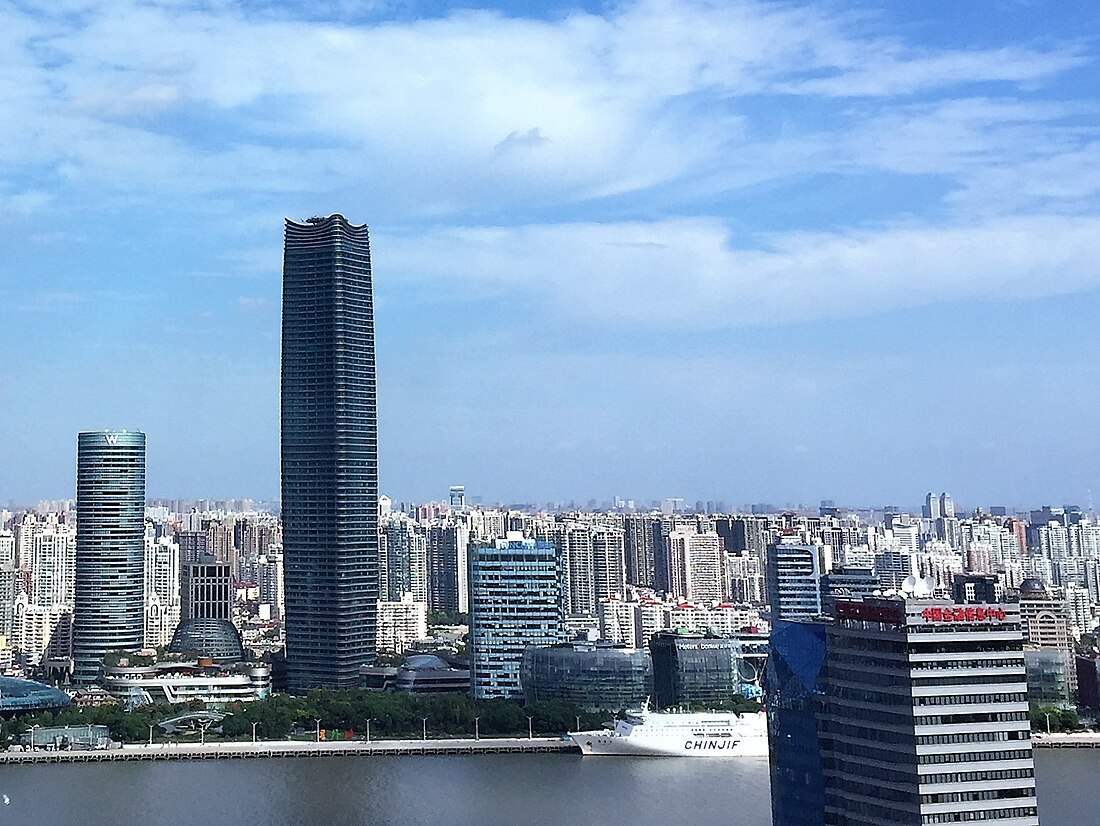Hongkou, Shanghai
District in Shanghai, People's Republic of China From Wikipedia, the free encyclopedia
Hongkou (ⓘ; formerly spelled Hongkew) is a district of Shanghai, forming part of the northern urban core. It has a land area of 23.48 km2 (9.07 sq mi) and a population of 757,498 as of 2020.[1] The district borders Yangpu to the east, Pudong to the southeast, Huangpu to the southwest, Jing'an to the west and Baoshan to the north.
This article needs additional citations for verification. (December 2009) |
Hongkou
虹口区 | |
|---|---|
 The View of The North Bund, Hongkou, Shanghai | |
 | |
 Hongkou in Shanghai | |
| Country | People's Republic of China |
| Municipality | Shanghai |
| Area | |
• Total | 23.48 km2 (9.07 sq mi) |
| Population (2020) | |
• Total | 757,498 |
| • Density | 32,000/km2 (84,000/sq mi) |
| Time zone | UTC+8 (China Standard) |
| Website | www |
| Hongkou, Shanghai | |||||||
|---|---|---|---|---|---|---|---|
| Simplified Chinese | 虹口区 | ||||||
| Traditional Chinese | 虹口區 | ||||||
| Postal | Hongkew | ||||||
| |||||||
It is the location of the Astor House Hotel, Broadway Mansions, Lu Xun Park, and Hongkou Football Stadium. It was once known as Shanghai's "Little Tokyo." Hongkou is home to the Shanghai International Studies University, the Shanghai University of Finance and Economics, and the 1933 Old Millfun.
History
During the Tang dynasty, the area in modern Hongkou District may have been a beach included in a seawall (捍海塘) near the East China Sea. In the early Ming dynasty, it became known as 黃埔口 (Huangpukou) or 洪口 (Hongkou), as there is a river mouth debouched into the Huangpu River, in the early Qing dynasty, it was renamed as 虹口 (Hongkou).[2]
In 1845, an American bishop W. J. Boone bought an area of land there, and it later evolved into the American Concession in Shanghai in 1848 and merged into the International Concession in 1863, it was in large part reduced to rubble during the Second World war when Shanghai was occupied by the Japanese.[3] 20,000 Ashkenazi Jewish refugees from Nazi-occupied Europe lived in an overcrowded square-mile section known to as the Shanghai Ghetto, in the Tilanqiao neighborhood of Hongkew.[4]
In 1947, it was renamed as Hongkou District.
Subdistricts
Hongkou is responsible for the administration of the following subdistricts.
| Name | Chinese (S) | Hanyu Pinyin | Shanghainese Romanization | Population (2010)[5] | Area (km2) |
|---|---|---|---|---|---|
| Ouyang Road Subdistrict | 欧阳路街道 | Ōuyánglù Jiēdào | oe yan lu ka do | 73,328 | 1.67 |
| Quyang Road Subdistrict | 曲阳路街道 | Qūyánglù Jiēdào | chioq yan lu ka do | 102,564 | 3.05 |
| Guangzhong Road Subdistrict | 广中路街道 | Guǎngzhōnglù Jiēdào | kuaon tzon lu ka do | 122,669 | 2.89 |
| Jiaxing Road Subdistrict | 嘉兴路街道 | Jiāxìnglù Jiēdào | cia ka xin lu ka do | 125,634 | 2.63 |
| Liangcheng Xincun Subdistrict | 凉城新村街道 | Liángchéng Xīncūn Jiēdào | lian zen sin tsen ka do | 98,094 | 3.14 |
| Sichuan North Road Subdistrict | 四川北路街道 | Sìchuānběilù Jiēdào | sy tseu poq lu ka do | 87,401 | 2.33 |
| Tilanqiao Subdistrict | 提篮桥街道 | Tílán qiáo Jiēdào | tiq leh djio ka do | 113,751 | 2.36 |
| Jiangwanzhen Subdistrict | 江湾镇街道 | Jiāngwānzhèn Jiēdào | kaon ue tzen ka do | 129,035 | 4.17 |
Economy

Previously Lianhua Supermarket had its Shanghai office in the district.[6]
Schools
- Hongkou Experimental School
- Shanghai Beihong Senior High School
- Shanghai Beijiao Senior High School
- Shanghai Chengzhong Senior High School
- Shanghai Jiguang Senior High School
- Shanghai No.1 Normal Senior High School
- Shanghai Fuxing Senior High School
- Shanghai Hongkou Senior High School
- Shanghai Hainan middle school
International schools
Russian Consulate School in Shanghai is a Russian overseas primary school operated by the Russian Ministry of Foreign Affairs, located on the grounds of the Consulate-General of Russia in Shanghai in Hongkou District.[7]
Transportation
Metro
Hongkou is currently served by five metro lines operated by Shanghai Metro:
- Line 3 - Dongbaoxing Road, Hongkou Football Stadium 8 , Chifeng Road, Dabaishu, Jiangwan Town
- Line 4 - Hailun Road 10 , Linping Road
- Line 8 - Siping Road 10 , Quyang Road, Hongkou Football Stadium 3
- Line 10 - North Sichuan Road, Hailun Road 4 , Youdian Xincun, Siping Road 8
- Line 12 - International Cruise Terminal, Tilanqiao
References
Further reading
External links
Wikiwand - on
Seamless Wikipedia browsing. On steroids.
